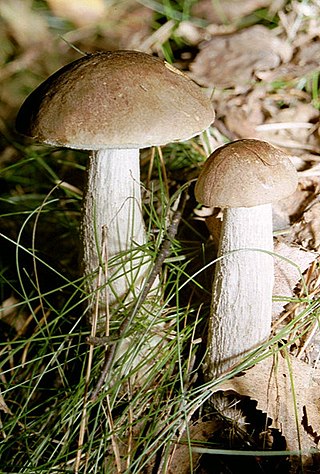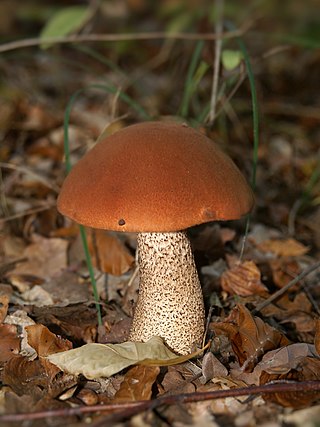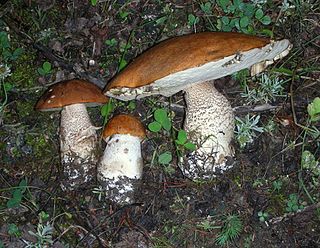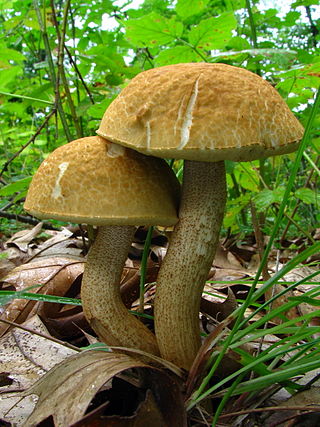
Leccinum scabrum, commonly known as the rough-stemmed bolete, scaber stalk, and birch bolete, is an edible mushroom in the family Boletaceae, and was formerly classified as Boletus scaber. The birch bolete is widespread in Europe, in the Himalayas in Asia, and elsewhere in the Northern Hemisphere, occurring only in mycorrhizal association with birch trees. It fruits from June to October. This mushroom is also becoming increasingly common in Australia and New Zealand where it is likely introduced.

Leccinum is a genus of fungi in the family Boletaceae. It was the name given first to a series of fungi within the genus Boletus, then erected as a new genus last century. Their main distinguishing feature is the small, rigid projections (scabers) that give a rough texture to their stalks. The genus name was coined from the Italian Leccino, for a type of rough-stemmed bolete. The genus has a widespread distribution, especially in north temperate regions, and contains about 75 species.

Leccinum aurantiacum is a species of fungus in the genus Leccinum found in forests of Eurasia and North America. It has a large, characteristically red-capped fruiting body. In North America, it is sometimes referred to by the common name red-capped scaber stalk. Some uncertainties exist regarding the taxonomic classification of this species in Europe and North America. It is considered edible, but must be cooked thoroughly.

Leccinum manzanitae is an edible species of bolete fungus in the family Boletaceae. Described as new to science in 1971, it is commonly known as the manzanita bolete for its usual mycorrhizal association with manzanita trees. Its fruit bodies (mushrooms) have sticky reddish to brown caps up to 20 cm (8 in), and its stipes are up to 16 cm (6.3 in) long and 3.5 cm (1.4 in) thick. They have a whitish background color punctuated with small black scales known as scabers. Found only in the Pacific Northwest region of the United States and Canada, it is the most common Leccinum species in California. The mushroom is edible, although opinions vary as to its quality. L. manzanitae can be usually distinguished from other similar bolete mushrooms by its large size, reddish cap, dark scabers on a whitish stipe, and association with manzanita and madrone.

Leccinum arenicola is a species of bolete mushroom in the family Boletaceae. Described in 1979, the fruit bodies (mushrooms) grow in sand dunes from New Brunswick south to Cape Cod.

Leccinum insigne, commonly known as the aspen bolete or the aspen scaber stalk, is a species of bolete fungus in the family Boletaceae. Described as new to science in 1966, it is found in North America, where its range extends from eastern Canada south to New Jersey and west to the northern Rocky Mountains. It is a good edible mushroom, but there have been documented cases of adverse reactions; these range from headaches to gastrointestinal distress, which may or may not be attributed to food sensitivities alone. The specific epithet insigne means "distinctive or outstanding".

Leccinum holopus, commonly known as the white birch bolete, white bog bolete, or ghost bolete, is a species of bolete fungus in the family Boletaceae found in northern Asia, Europe, and northeastern North America. It associates with birch trees and is typically found in boggy or swampy areas, often growing among sphagnum moss.

Leccinellum rugosiceps, commonly known as the wrinkled Leccinum, is a species of bolete fungus. It is found in Asia, North America, Central America, and South America, where it grows in an ectomycorrhizal association with oak. Fruitbodies have convex, yellowish caps up to 15 cm (5.9 in) in diameter. In age, the cap surface becomes wrinkled, often revealing white cracks. The stipe is up to 10 cm (3.9 in) long and 3 cm (1.2 in) wide, with brown scabers on an underlying yellowish surface. It has firm flesh that stains initially pinkish to reddish and then to grayish or blackish when injured. The pore surface on the cap underside is yellowish. Fruitbodies are edible, although opinions vary as to their desirability.

Sutorius eximius, commonly known as the lilac-brown bolete, is a species of fungus in the family Boletaceae. This bolete produces fruit bodies that are dark purple to chocolate brown in color with a smooth cap, a finely scaly stipe, and a reddish-brown spore print. The tiny pores on the cap underside are chocolate to violet brown. It is widely distributed, having been recorded on North America, South America, and Asia, where it grows in a mycorrhizal relationship with both coniferous and deciduous trees.
Leccinum subatratum is a species of bolete fungus in the family Boletaceae. It was described as new to science in 1968 by mycologists Alexander H. Smith, Harry Delbert Thiers, and Roy Watling.
Leccinum subrobustum is a species of bolete fungus in the family Boletaceae. It was described as new to science in 1968 by mycologists Alexander H. Smith, Harry Delbert Thiers, and Roy Watling.
Leccinellum viscosum is a species of fungus in the bolete family. Found in Belize, it grows in sandy soil near Pinus caribaea and Quercus peduncularis. It was described as new to science in 2009 by mycologists Roy Halling and Beatriz Ortiz.
Leccinum barrowsii is a species of bolete fungus in the family Boletaceae. It is found in the southwestern United States, where it grows on the ground under conifers. The bolete was described as new to science in 1966 by mycologists Alexander H. Smith, Harry Delbert Thiers, and Roy Watling. The specific epithet honours the collector, Charles "Chuck" Barrows (1903–1989).
Leccinum boreale is a species of bolete fungus in the family Boletaceae. The bolete was described as new to science in 1966 by mycologists Alexander H. Smith, Harry Delbert Thiers, and Roy Watling.
Leccinum brunneum is a species of bolete fungus in the family Boletaceae. Found in the Sierra Nevada region of California, it was described as new to science in 1971 by mycologist Harry Delbert Thiers.

Leccinum insolens is a species of bolete fungus in the family Boletaceae. It was described as new to science in 1968 by mycologists Alexander H. Smith, Harry D. Thiers, and Roy Watling. The variety brunneomaculatum was also described by these authors.

Leccinum arbuticola is a species of bolete fungus in the family Boletaceae. It was described as new to science in 1975 by mycologist Harry Delbert Thiers, from collections made in Nevada County, California. It grows in association with madrone.
Leccinum aurantiellum is a species of bolete fungus in the family Boletaceae. Found in the United States, it was described as new to science in 1971 by Harry Delbert Thiers.










